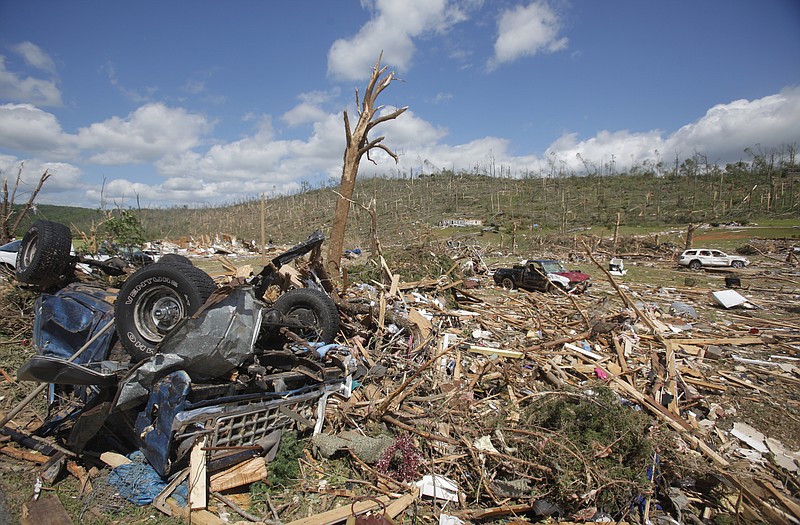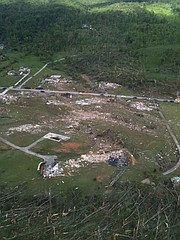It took the deadliest tornado outbreak in modern history to shatter the false sense of security among Chattanooga area residents - even meteorologists.
In the Tennessee Valley, where 81 people lost their lives five years ago, many believed the mountains would protect them from violent twisters. Even scientists thought they understood how tornadoes were formed, that technology was sophisticated enough to warn people far enough in advance.
"We thought warnings were getting so good that this could never happen again," said Erik Rasmussen, the project manager for VORTEX Southeast, a newly funded federal project to study tornadoes in the South. "We were lulled into the idea that only one type of storm produces tornadoes and thought we could apply that to the Southeast. But that's not how it works."
Days before April 27, 2011, meteorologists predicted a potentially "high-risk" storm for the region. But as the thunderstorms formed supercells, 90 percent produced tornadoes - the normal rate is 25 percent - that swept in three violent waves that began in the region of DeKalb County, Ala., at 7:30 a.m. and continued across Georgia and Southeast Tennessee until 10 p.m.
As the powerful storms moved through the region, cell towers and sirens were knocked out and electrical towers toppled, leaving residents without power - or warning.
Many had no idea that four EF4 tornadoes and an EF5 twister packing winds of more than 200 mph were heading toward them in the night.
In Ringgold, Ga., a family of four was killed when a violent EF4 tornado traveled over White Oak Mountain and struck Cherokee Valley. In Apison, Tenn., the same tornado killed four generations of one family hiding in a trailer. The region's deadliest tornado of the day touched down in Alabama in the Lakeview community. It continued down a 34-mile lethal path, killing 33 people, including a 20-year-old woman and her great-grandmother and a couple in their 60s who were grade-school sweethearts.
In the end, storms across the South killed 316 people that day and caused billions of dollars in destruction.
Once the magnitude of the devastation was calculated, Rasmussen said, scientists began to ask: "What are we missing? How can so many people be killed by tornadoes?"
To answer these questions, the National Oceanic and Atmospheric Administration, or NOAA, received $5.5 million from Congress to launch the largest study of tornadoes in the Southeast.
Officials said the project is unique because it will study how residents react to warnings ahead of time, as well as begin to study why the Southeast is a hub for some of the deadliest tornadoes in the country.
***
For decades, meteorologists have studied tornadoes on the Great Plains, often referred to as Tornado Alley, where funnel clouds are spotted from miles away and are easy to chase along the flatlands. But in the Southeast, where tornadoes aren't as common but tend to be stronger, stay on the ground longer, and strike at night or in the winter, they have remained something of a mystery, experts say.
Before 2011, the deadliest recorded tornado outbreak was in the spring of 1974. Hundreds of twisters followed a similar path through the tri-state area, killing 310 people across Alabama, Georgia and Tennessee.
More than a decade later, Kevin Knupp, an atmospheric science professor at the University of Alabama in Huntsville, began to study tornado patterns. He hypothesized that the Earth's landscape could affect tornadoes. He began to document how tornadoes often lost strength after coming in contact with a mountain but picked up speed on the down-track of the slopes.
He argued that the Southeast was unique because of the roughness of the Earth's surface, which includes mountains and forests. But his work was relatively ignored, and even debunked, by some meteorologists - until April 27, 2011.
After examining the patterns of some of the 199 tornadoes from April 27 in Alabama, Georgia and Tennessee, Knupp concluded in a study published in 2014 that gravity waves and the landscape of the Earth frequently correlated with the intensity of the tornadoes. For example, several tornadoes formed in thickly tree-covered areas of Northeast Alabama, and several tornadoes dramatically sped up on the down-slope of a mountain, he concluded.
"The surface affects the tornadoes in ways we don't understand yet," Knupp said. "Does it actually make the creation of a tornado more likely?"
He doesn't know the answer. But as part of NOAA's VORTEX Southeast project, meteorologists from across the nation are trying to understand exactly what occurs at a tornado's 1,000-foot level and lower.
In Huntsville, Ala., a small team of meteorologists has partnered with a drone company to fly over an area damaged by an EF2 tornado.
In April, the drone, which weighs less than 2 pounds and is 3 feet long, began taking pictures of the area where the tornado touched down, snapping trees and ripping roofs from farm homes. Once the data is collected, the researchers will be able to use mapping software to study the storm's movements.
"We're trying to figure out if there is a real relationship [with the mountains and trees] or is this just chance?" said Tony Lyza, Knupp's graduate student at UAH.
If scientists could better understand how tornadoes form, it might increase warning times for people living in areas most affected by the storms, Lyza said. It could even change how people think about where they live.
But the research is controversial.
Harold Brooks, senior research meteorologist at NOAA's Storm Prediction Center in Norman, Okla., remains skeptical of Knupp's study on influences of terrain and topography on tornadoes.
Brooks believes topography and small-scale study of tornado formations, a study in which he's now involved, might not show real patterns in storm behavior as much as random events that are hard to accurately associate with one another.
But next year, VORTEX Southeast will spend the spring studying storms as they pass over Sand Mountain near Rainsville, Ala. - near where multiple tornadoes have crossed over since 2011 when 25 people were killed in the area - to find out if there is a direct link. The project received another $5.5 million for 2017. Knupp estimates it could take up to 10 years to fully understand the connection.
***
As someone who has lived in Northeast Alabama nearly all of his life, DeKalb County Emergency Management Agency Deputy Director Michael Posey doesn't need a scientist to tell him the mountains affect tornadoes.
"We'll have no indication of a tornado, and then suddenly there will be one in northern Fort Payne," Posey said. "It goes over the mountain, and suddenly we get a quick EF2 or EF3 tornado."
Since 2011, two of the four tornado outbreaks in DeKalb County developed quickly and with no warning, striking the southern part of the county in 2013 and northern Fort Payne in 2015, he said. Folks in the area have learned to be cautious and watch the sky, grab their weather radios and check announcements online.
After April 27, DeKalb County and surrounding government entities built nine storm shelters and hundreds of residents rebuilt with their own personal storm shelters. The county now keeps a voluntary registry of where those shelters are located.
Most of the area has been rebuilt, but the path of the tornado - which slammed into the DeKalb County Schools Coliseum before mowing down country homes, a Huddle House, a church and fields - is still evident by the landscape, and the area looks eerily naked without trees these days.
But even so, Posey said, his team is working on ways to deliver warnings that will make residents listen.
When DeKalb emergency management officials are alerted to the possibility of a storm, they watch it closely, then they try to gauge how people react to their tweets and Facebook posts. If the warnings increase, they try to put out specific messages that tell people exactly when to expect the tornado and for how long they are in danger.
After the most recent tornado warning, Posey said, six of the nine shelters were full, which he feels was a good indicator that people were listening to the warnings.
One of the findings after the April 27, 2011, tornadoes was that warnings were too vague and didn't communicate the level of danger that was coming. And with Doppler radar warnings, only one in four warnings leads to a verified tornado, experts said, so that creates a risk that people will stop listening when a serious storm is around.
In Hamilton County, EMA spokeswoman Amy Maxwell said residents also seem to be taking warnings more seriously. Many now have weather radios, and a few even rebuilt their homes with storm shelters.
"Technology and social media have definitely changed [things] for the better," Maxwell said of people heeding warnings.
WRCB-TV Chief Meteorologist Paul Barys said he is still trying to convince Chattanoogans to make a plan ahead of time before a tornado warning is issued, but he said more people are listening now.
"In Oklahoma, everybody knows what to do. But in the South, everybody doesn't know what to do. I've been preaching this for 30 years: 'Y'all need to know what to do,'" Barys said.
When he first moved to Chattanooga, people told him, "We can't have a tornado around here. The mountains will protect us."
But after April 27, 2011, people called to thank him for saving their lives, Barys said.
One of those people was Robert Colby, an Apison resident who is the director of the Chattanooga/Hamilton County Air Pollution Control Bureau.
That evening, Colby was one of the few people who still had power, and when Barys said a tornado was on the ground in Apison he hid in a closet under the stairwell with his wife, son, mother-in-law and one of the family dogs.
As he shut the door to the closet, he thought, "This will never happen. But I'm going to be prepared."
A second later, the house disintegrated around them.
Staff writer Ben Benton contributed to this story.
Contact staff writer Joy Lukachick Smith at 423-757-6659 or jsmith@timesfreepress.com.

